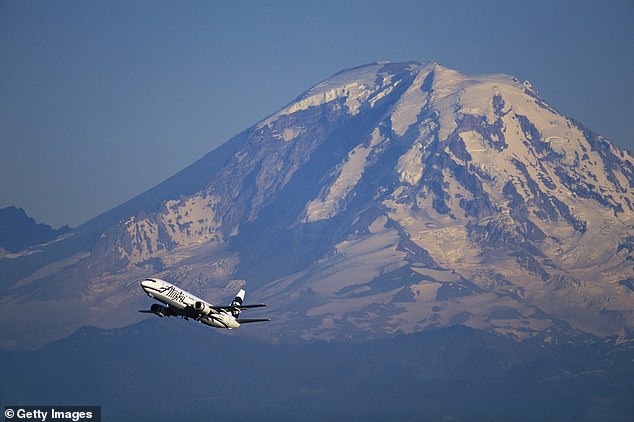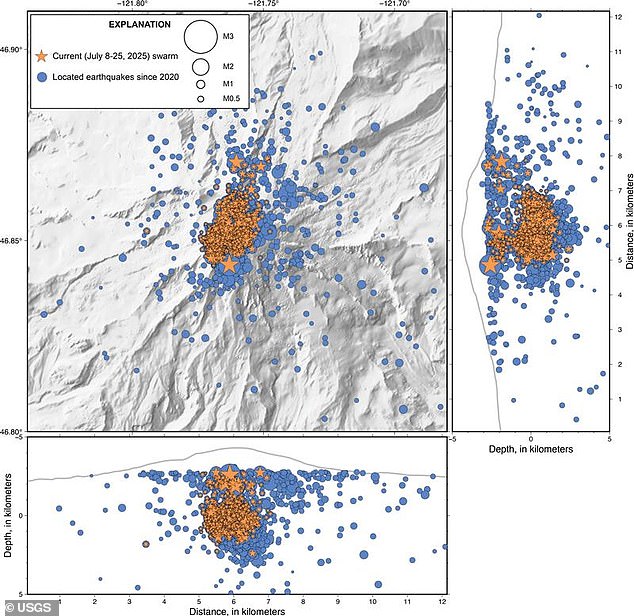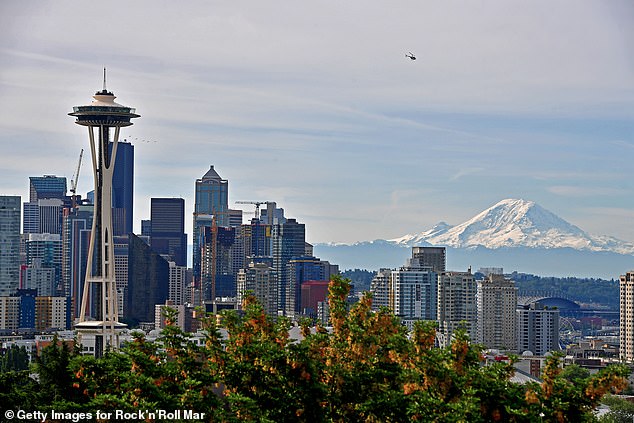Over 1,000 earthquakes have rocked Washington’s Mount Rainier in the largest ever seismic swarm recorded at this active volcano, waiting to erupt.
Experts from the US Geological Survey (USGS) revealed that this record-breaking earthquake swarm started on July 8 and has continued ever since.
As of July 25, geologists have recorded at least 1,010 small earthquakes around the mountain, which is one of the most dangerous volcanoes in the US.
While the agency said that even more tremors will likely be added to this total, they’ll be too small to cause any damage and likely won’t even be felt by locals.
The most powerful of these earthquakes was measured at 2.4 in magnitude, which is weaker than what can typically be felt by people and rarely causes any damage.
These kinds of swarms can occur once or twice a year, but they normally only last a few days, leaving USGS researchers with a concerning mystery right now.
‘Most swarms at Mount Rainier (there are 1-2 annually) last less than a week. That being said, we do not have a good estimate for how long this swarm may last, and whether it will intensify or peter out,’ the agency admitted on Friday.
Although USGS added that an eruption doesn’t seem imminent, Mount Rainier remains one of the most active volcanoes in the Pacific Northwest’s Cascade Range, and a devastating eruption remains a real possibility in the near future.

Mount Rainier (pictured behind a commercial airplane) has experienced over 1,000 earthquakes since July 8, one of the biggest swarms recorded

Researchers with the US Geological Survey have released a map showing more than 1,000 small earthquakes detected at Mount Rainier between July 8 and July 25
Experts have warned that Mount Rainier would be an extremely major threat to the public during an eruption due to its volcanic mudflows known as lahars, ash fall, and pyroclastic flows.
This huge, active stratovolcano towers over millions of people in major cities such as Seattle, Tacoma, and Yakima in Washington, as well as Portland, Oregon.
Even though Mount Rainier has not produced a significant eruption in more than 1,000 years, experts have kept a very close eye on it due to its potential to blow at any time, and the widespread destruction such an event would cause.
When this volcano eventually blows, it won’t be lava flows or choking clouds of ash that threaten surrounding cities, but the lahars.
These violent, fast-moving mudflows that can tear across entire communities in a matter of minutes. The largest lahars can crush, bury, or carry away almost anything in their paths.
‘Based on our observations, we think the most likely cause of the earthquakes is water moving around the crust above the magma chamber,’ researchers with the USGS Cascades Volcano Observatory (CVO) wrote in a statement.
For now, the USGS has kept their alert level at ‘normal’ despite the continued seismic activity around the mountain.
‘The volcano is not ‘due’ for an eruption and we do not see any signs of a potential eruption at this time,’ the researchers declared.

Mount Rainier (right) sits dangerously close to major US cities like Seattle (pictured), which has a population of more than 750,000
This latest swarm easily surpassed the last large string of earthquakes at Mount Rainier, which came in 2009.
That earthquake swarm only lasted three days and produced around 120 earthquakes.
The swarm, which started during the morning of July 8 saw up to 41 minor earthquakes registering every hour.
Since then, the seismic activity has cooled down to just a few each hour, but the tremors still haven’t stopped altogether.
Despite experiencing hundreds more earthquakes than what was felt in 2009, geologists have said the latest swarm continues to fall within what scientists consider ‘normal background levels of activity’ for Mount Rainier.
While USGS has tried to calm the public regarding this massive uptick in earthquakes in Washington, Mount Rainier is not the only major volcano in the Pacific Northwest that could see an eruption in the next few years.
Just like Mount Rainier, scientists have detected around 100 earthquakes per day, with recent peaks hitting 300 a day. Seismic activity is a sign magma is moving up through cracks in the volcano.
Experts have said pressure is building, magma is on the move, and the stage may be set for an underwater eruption similar to the spectacular one that occurred in 2015, which saw up to 2,000 quakes per day.
